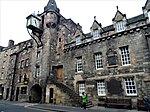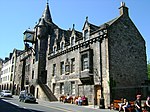Acheson House

Acheson House is a 17th-century house in the Old Town of Edinburgh, Scotland. It was built in 1633 for Sir Archibald Acheson, 1st Baronet, Secretary of State of Scotland for King Charles I. It did not stay in the Acheson family, and during the 19th century it declined like much of the Old Town. Slum clearance led the city council to acquire the building in 1924, but the Marquess of Bute bought it to have it restored during the 1930s. It was later used by church and arts groups, but was vacant between 1991 and 2011. In November 2011, Acheson House became the base for the Edinburgh World Heritage Trust. The ground floor of the building will become part of the Museum of Edinburgh, based in the adjacent Huntly House.The house is on the Canongate, the lower part of the Royal Mile, and is protected as a category A listed building as an "outstanding example of a large, early 17th century Scottish townhouse."
Excerpt from the Wikipedia article Acheson House (License: CC BY-SA 3.0, Authors, Images).Acheson House
Bakehouse Close, City of Edinburgh Canongate
Geographical coordinates (GPS) Address Nearby Places Show on map
Geographical coordinates (GPS)
| Latitude | Longitude |
|---|---|
| N 55.9512 ° | E -3.1791 ° |
Address
Acheson House
Bakehouse Close
EH8 8DD City of Edinburgh, Canongate
Scotland, United Kingdom
Open on Google Maps











